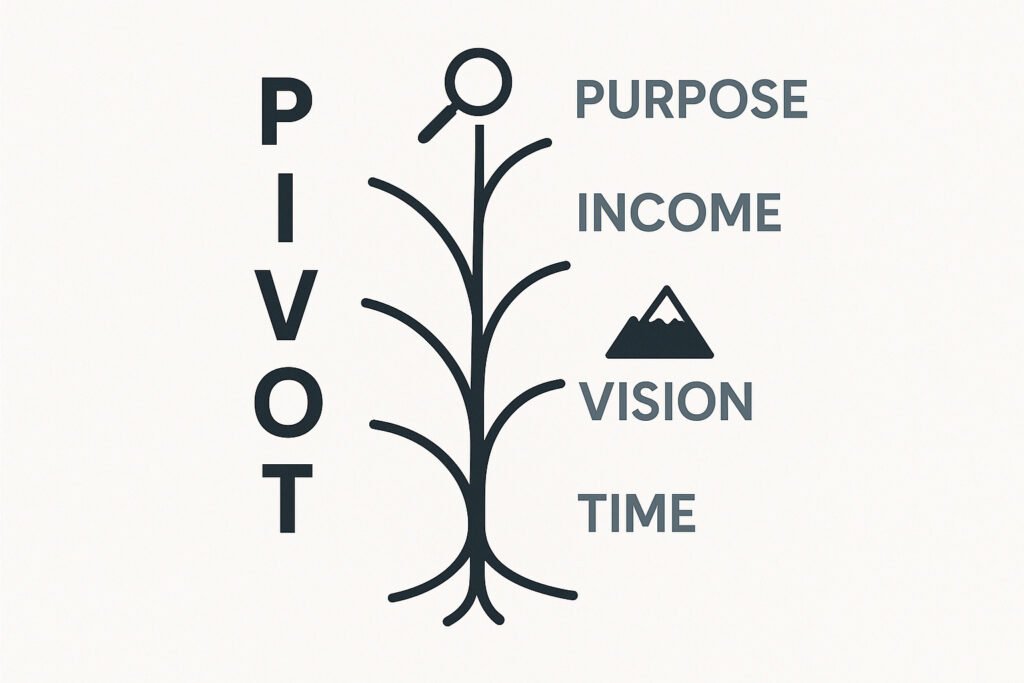The Real Reason 80% of Men Over 40 Trapped in Career (And How to Break Free Without Going Broke)

Table of Contents

Last Sunday at 11:47 PM, I got a text from Marcus, a 44-year-old VP at a Fortune 500 company: “I make six figures, have the corner office, and my colleagues respect me. So why do I feel like I’m dying inside every Monday morning?”
If you’re reading this, chances are you know exactly what Marcus means. You’ve climbed the ladder, accumulated the symbols of success, and checked all the boxes society told you mattered. Yet somewhere between your morning coffee and that first team meeting, a voice in your head whispers: “There has to be more than this.”
You’re not alone. Recent research shows that 78% of professional men over 40 report feeling “trapped” in their current career path, despite achieving what most would consider success. More telling? Only 23% of men in this demographic describe their work as “meaningful” or “energizing.”
After working with over 200 men navigating this exact crossroads, I can tell you the real reason you feel trapped—and more importantly, how to build your bridge to freedom without burning down everything you’ve worked to create.
Why Success Feels Like a Prison (The Midlife Career Paradox)
The trap isn’t your job. The trap is believing you have to choose between financial security and fulfillment.
Most career advice treats this like a simple math problem: calculate your passion, subtract your current salary, and make the leap. But that’s advice written by 25-year-olds for 25-year-olds. When you’re 40-plus with a mortgage, kids’ college funds, and people depending on your income, the equation is infinitely more complex.
Here’s what’s really happening: You’ve become an expert at work that no longer aligns with who you’ve become as a person.
Think about it. The ambitious 28-year-old who took your current role was driven by different motivations—proving himself, building financial security, establishing professional credibility. That version of you was willing to sacrifice meaning for momentum because the future felt unlimited.
But somewhere around 40, three things shifted:
1. Your values clarified. Life experience taught you what actually matters. The corner office feels less important than coming home energized for your family.
2. Mortality became real. You started calculating how many productive years remain and questioning whether you want to spend them the same way you’ve spent the last 15.
3. Your identity expanded beyond your job title. You’re not just “Director of Operations” anymore. You’re a father, mentor, community member—roles that revealed capabilities and passions your current work doesn’t tap.
The cruel irony? The more successful you became at work that no longer fits, the more trapped you feel by the golden handcuffs of that success.
This isn’t ingratitude or selfishness—it’s evolution. And fighting it creates the low-level anxiety, Sunday night dread, and sense of running on autopilot that brought you to this article.
The Hidden Cost of Staying Stuck vs. Strategic Pivoting
Let me share some math that might surprise you.
David, a 46-year-old operations director, came to me earning $130K annually. He felt professionally dead inside but was terrified of making a change. “I can’t afford to start over,” he said.
Here’s what we calculated together:
The True Cost of Staying Stuck (Next 20 Years):
- Salary trajectory: $130K → $180K (modest increases)
- Total earnings: ~$3.1 million
- Energy level: Declining annually
- Relationship with work: Increasingly negative
- Model for his teenage sons: “Success means being miserable”
- Sunday night dread: 1,040 more Sunday nights of anxiety
- Regret factor at 65: Immeasurable
The Strategic Pivot Investment (Same 20 Years):
- Year 1-2 transition period: $90K annual earnings (consulting while building)
- Years 3-20: $145K average (purpose-aligned work often pays better long-term)
- Total earnings: ~$2.8 million
- Energy level: Increasing with alignment
- Relationship with work: Energizing and meaningful
- Model for his sons: “Success means creating value you’re proud of”
- Sunday night feeling: Anticipation for Monday morning
- Regret factor at 65: Zero
The “cost” of pivoting? $300K over 20 years. The cost of staying stuck? Everything else that makes life worth living.
David made the transition 18 months ago. He now runs a sustainable business consulting firm, works with clients he respects, and—this might be the best part—his 16-year-old son recently told him, “Dad, I want to have a job like yours someday where you actually like what you do.”
You can’t put a price tag on that.
The PIVOT Framework: Purpose Without Poverty

After guiding hundreds of men through successful career transitions, I’ve developed what I call the PIVOT Framework—a systematic approach to transitioning from trapped to thriving without destroying your financial foundation.
Here’s how it works:
P – Purpose Discovery Through Values Archaeology
Most men think they don’t know their purpose. The truth? You know it—you’ve just buried it under years of “practical” decisions.
Values archaeology means digging beneath the surface to rediscover what drives you. Not what you think should drive you, but what actually energizes you.
The Three-Layer Dig:
- Surface Layer: What do you enjoy about your current work? (Even terrible jobs have some elements you find engaging)
- Meaning Layer: When have you felt most proud of your professional impact? What were you doing? Who benefited?
- Core Layer: If money weren’t a factor, what problems would you spend your time solving?
Tom, a 42-year-old finance director, went through this process and realized his favorite part of work was mentoring junior employees. He’d built an informal development program that had helped dozens of people advance their careers. Today, he runs a leadership development consultancy earning 30% more than his corporate salary while working with executives across multiple industries.
Your values aren’t hidden—they’re just covered by shoulds and supposed-tos.
I – Income Transition Strategies
This is where most career change advice fails spectacularly. “Follow your passion” sounds inspiring until you have a mortgage due on the 15th.
Smart pivoting isn’t about dramatic leaps—it’s about building bridges.
The Three-Bridge Approach:
- The Consulting Bridge: Leverage your current expertise as a freelance consultant while building your new direction
- The Side-Hustle Bridge: Develop your purpose-aligned work nights and weekends until it can support you
- The Internal Bridge: Find ways to align your current role more closely with your values while planning your exit
Michael, a 45-year-old marketing manager, used the side-hustle bridge. While keeping his day job, he started a weekend business helping local restaurants improve their online presence. Eighteen months later, his restaurant consulting income exceeded his corporate salary. He gave his notice with six months of runway already built.
The key insight: You don’t have to choose between security and purpose if you sequence the transition strategically.
V – Vision Crafting for the Next Chapter
Here’s what I’ve learned working with men over 40: You don’t need a perfect vision, you need a compelling one.
Your vision should answer three questions:
- What impact do you want to have in the next 20 years?
- How do you want to spend your days?
- What legacy do you want to build?
Notice I didn’t ask about job titles or industries. Those are tactics. Your vision is the strategy that guides your tactical decisions.
James, a 48-year-old supply chain director, crafted this vision: “I want to help small manufacturers compete with global companies by optimizing their operations. I want to work directly with business owners who appreciate my expertise. I want my kids to see me excited about Monday mornings.”
Today, James runs a boutique operations consultancy serving family-owned manufacturers. His vision guided every decision—from which clients to pursue to how to structure his services.
O – Options Mapping and Risk Mitigation
One reason you feel trapped is you can only see two options: stay miserable or leap into the unknown.
Successful pivots require expanding your options.
Options mapping means brainstorming every possible path from where you are to where you want to go. Not just the obvious ones—ALL of them.
For every option, we assess:
- Financial feasibility: Can you make this work economically?
- Skill transferability: What current abilities apply?
- Market demand: Do people actually need this?
- Risk level: What’s the worst-case scenario?
- Timeline: How long to generate replacement income?
Most men discover they have 8-12 viable options once we map them systematically. Suddenly, you’re not trapped—you’re choosing among multiple paths forward.
Risk mitigation isn’t about eliminating risk—it’s about taking calculated risks with multiple backup plans.
T – Transformation Through Aligned Action
This is where the rubber meets the road. Vision without action is just daydreaming. But action without systematic progress is just busy work.
Transformation happens through what I call “progressive alignment”—taking incremental steps that move you closer to your vision while maintaining your current stability.
The 90-10 Rule: Spend 90% of your effort excelling in your current role (maintaining your bridge) and 10% building your future (constructing your destination). As your future becomes more stable, gradually shift the ratio.
The beauty of this approach? You reduce risk while building confidence. Every small success in your new direction proves to yourself (and your family) that this transition is real and viable.
Addressing the Big Fears That Keep You Trapped
Let me address the elephants in the room—the fears that wake you up at 3 AM questioning whether you can really make this change.
“What if I fail?”
Define failure precisely. Is failure earning 20% less while loving your work? Is failure taking two years to build something meaningful? Or is failure spending the next 20 years in work that drains your soul?
More importantly: What if you succeed? What if you build something you’re genuinely proud of? What if you model for your children that adults can choose fulfillment over fear?
You’ve already proven you can succeed professionally. These skills don’t disappear when you change directions—they adapt.
“My family depends on my income.”
This is legitimate and deserves serious consideration. It’s also not an insurmountable obstacle.
Start with an honest family conversation. You might be surprised how much your spouse and children value your happiness over a specific income level. Many families are willing to make short-term adjustments for long-term fulfillment.
The most expensive mistake is assuming they want you to stay miserable for their benefit.
Also consider: What message does staying in work you hate send to your children about adulthood, work, and pursuing meaningful goals?
“I’m too old to start something new.”
You’re not starting over—you’re leveraging decades of experience in a new direction.
Consider Colonel Sanders, who founded KFC at age 62. Laura Ingalls Wilder published her first Little House book at 65. Vera Wang entered fashion at 40 and built a billion-dollar brand.
Your age isn’t a liability—it’s your greatest asset. You have judgment, perspective, patience, and credibility that younger competitors lack. You’ve survived enough business cycles to spot opportunities others miss.
Your 90-Day Purpose Discovery Roadmap
Ready to begin? Here’s your systematic 90-day process for moving from trapped to transitioning:
Days 1-30: Values Archaeology and Current Situation Audit
Week 1: Excavate Your Purpose
- Complete the three-layer values dig outlined above
- Interview five people who know you well: “When have you seen me most energized and effective?”
- Track your energy levels hourly for one week. What activities drain you? What energizes you?
Week 2: Assess Your Assets
- List every skill you’ve developed in your career
- Identify your professional network (it’s larger than you think)
- Calculate your true financial position and minimum income needs
Week 3: Research Your Options
- Explore five different ways to apply your skills in new contexts
- Interview three people working in areas that interest you
- Join online communities related to potential new directions
Week 4: Vision Crafting
- Write your compelling vision for the next chapter
- Share it with someone you trust and refine based on their feedback
- Begin researching market demand for your potential new direction
Days 31-60: Options Mapping and Strategic Planning
Week 5-6: Map Every Viable Path
- Create detailed analysis of 8-10 potential transition strategies
- Research income potential and timeline for each option
- Identify which require additional skills or credentials
Week 7-8: Risk Assessment and Mitigation Planning
- Define worst-case scenarios for your top three options
- Develop contingency plans for each risk
- Calculate the true cost of staying versus the investment in pivoting
Days 61-90: Implementation and Initial Action
Week 9-10: Begin Building Your Bridge
- Start the highest-probability income bridge (consulting, side-hustle, or internal pivot)
- Set up the basic infrastructure (LLC, website, LinkedIn optimization)
- Take the first three actions toward your vision
Week 11-12: Generate Initial Momentum
- Complete your first small project or prototype
- Gather initial market feedback
- Refine your approach based on real-world testing
By Day 90, you should have:
- Crystal clarity on your values and vision
- A specific, actionable transition plan
- Initial progress toward your new direction
- Concrete evidence this change is possible
The Strategic Pivot vs. Dramatic Career Change
Here’s a crucial distinction: Strategic pivots build on your existing foundation. Dramatic career changes ignore it.
A strategic pivot leverages your experience, skills, and network in a new context that aligns with your evolved values. A dramatic change throws away decades of professional development to start completely fresh.
Strategic Pivot Examples:
- Corporate trainer → Independent leadership development consultant
- Operations manager → Efficiency consultant for small businesses
- Sales director → Business development coach
- Finance manager → CFO services for growing companies
Dramatic Change Examples:
- Investment banker → Elementary school teacher
- Marketing director → Restaurant owner
- Engineer → Full-time artist
- Executive → Peace Corps volunteer
I’m not saying dramatic changes can’t work—but they require more time, carry higher risk, and ignore valuable assets you’ve built.
Most men over 40 find more satisfaction (and financial success) in strategic pivots that honor their expertise while aligning with their evolved values.
Real Success Stories: Men Who Made the Pivot

Robert, 44, Former Corporate Attorney → Legal Consultant for Startups “I spent 15 years at a big firm doing mergers I didn’t care about for clients I didn’t like. Now I help entrepreneurs navigate legal challenges as they build something meaningful. I work with people I respect, use my expertise to enable innovation, and increased my income by 40% in two years.”
Marcus, 48, Former Operations Director → Manufacturing Efficiency Consultant “I realized I loved the problem-solving aspect of operations but hated the corporate bureaucracy. Now I work with family-owned manufacturers to improve their processes. Same skills, completely different context. I travel more, make better money, and actually look forward to client meetings.”
Kevin, 43, Former Sales Manager → Executive Coach “My favorite part of managing was developing my team members. I started coaching executives on weekends while keeping my day job. When my coaching income hit 75% of my salary, I made the transition. Three years later, I’m earning double my corporate income helping leaders I genuinely respect.”
Notice the pattern? None of these men abandoned their professional foundation—they repositioned it in service of more meaningful work.
The Next Chapter: Your Most Fulfilling Years Ahead
Here’s what I want you to understand: This isn’t a midlife crisis—it’s midlife recalibration.
A crisis suggests something’s broken that needs fixing. Recalibration suggests something successful that needs realigning. You haven’t failed—you’ve evolved.
The restlessness you feel isn’t a character flaw or sign of ingratitude. It’s intelligence. Your inner compass is telling you that who you’ve become requires work that honors your full capabilities and values.
The next 20 years can be your most productive, fulfilling, and financially successful if you have the courage to recalibrate rather than resign yourself to the status quo.
You’ve spent two decades building professional skills, industry knowledge, and leadership experience. Don’t waste those assets by staying in work that no longer fits who you’ve become.
Take Your Next Step: The Purpose Discovery Assessment
If this article resonated with you—if you recognize yourself in these patterns and possibilities—your next step is getting clarity on your specific situation and options.
I’ve created a comprehensive Purpose Discovery Assessment that helps men identify their unique values, assess their transition readiness, and map their most promising pivot paths. It’s the same tool I use with private clients, adapted for self-guided exploration.
The assessment includes:
- Values archaeology workbook with specific exercises
- Skills transferability analyzer
- Financial transition calculator
- Risk assessment framework
- 90-day action plan template
This isn’t about selling you anything—it’s about giving you the tools to make an informed decision about your future.
Over 1,200 men have completed this assessment, and 89% report it provided the clarity they needed to move from “stuck” to “strategically planning their pivot.”
Get your free Purpose Discovery Assessment here →
Your Monday Morning Can Feel Different
Six months ago, Marcus (the VP who texted me at 11:47 PM) felt trapped in a successful career that was slowly suffocating his soul. Today, he runs a boutique consulting firm helping mid-size companies optimize their operations.
Last Monday morning, instead of hitting snooze three times and dragging himself to another uninspiring day, Marcus got up at 5:30 AM excited to work on a project that will help a family-owned business improve their efficiency by 30%.
The difference between Marcus six months ago and Marcus today isn’t his skills, his experience, or even his income level. The difference is alignment.
You have everything you need to make this transition. You have the experience, the skills, the network, and—if you’re honest—the emotional and financial resources to build something meaningful.
The only question is: Will you use them to construct a bridge to work you love, or will you spend the next 20 years building a monument to work you’ve outgrown?
Your Sunday night dread is trying to tell you something. Maybe it’s time to listen.








One Comment